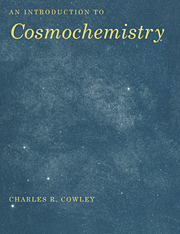Book contents
- Frontmatter
- Contents
- Foreword
- 1 Overview
- 2 Minerals: An Introduction to the Nomenclature and Chemistry
- 3 A Brief Introduction to Petrology
- 4 A Résumé of Thermodynamics and Statistical Mechanics
- 5 Condensation Sequences and the Geochemical Classification of the Elements
- 6 The Theory of the Bulk Composition of the Planets
- 7 Meteorites and the Standard Abundance Distribution (SAD)
- 8 An Introduction to Isotope Geology with an Emphasis on Meteorites
- 9 Some Concepts from Nuclear Physics
- 10 Energy Generation in Stars and Nucleosynthesis
- 11 Atomic and Molecular Spectra
- 12 The Analysis of Stellar Spectra
- 13 The Chemistry of Stars and Stellar Systems
- 14 Cold, Non-stellar Material in Galaxies
- 15 Emission-Line Regions and their Chemical Abundances
- 16 Abundances of the Elements in Galaxies
- Appendix
- References
- Index
10 - Energy Generation in Stars and Nucleosynthesis
Published online by Cambridge University Press: 05 June 2012
- Frontmatter
- Contents
- Foreword
- 1 Overview
- 2 Minerals: An Introduction to the Nomenclature and Chemistry
- 3 A Brief Introduction to Petrology
- 4 A Résumé of Thermodynamics and Statistical Mechanics
- 5 Condensation Sequences and the Geochemical Classification of the Elements
- 6 The Theory of the Bulk Composition of the Planets
- 7 Meteorites and the Standard Abundance Distribution (SAD)
- 8 An Introduction to Isotope Geology with an Emphasis on Meteorites
- 9 Some Concepts from Nuclear Physics
- 10 Energy Generation in Stars and Nucleosynthesis
- 11 Atomic and Molecular Spectra
- 12 The Analysis of Stellar Spectra
- 13 The Chemistry of Stars and Stellar Systems
- 14 Cold, Non-stellar Material in Galaxies
- 15 Emission-Line Regions and their Chemical Abundances
- 16 Abundances of the Elements in Galaxies
- Appendix
- References
- Index
Summary
Introduction
Most stars are converting hydrogen to helium by either the proton–proton chain, or the CNO cycle. We will discuss these processes in §10.2. Nuclear energy is available by the combination or fusion of nuclei less massive than A = 56 (Fe). This nucleus has the maximum binding energy per nucleon. By far the largest fraction of energy in this process is released in the first step, the formation of helium from hydrogen. A rough figure for the ratio of the time that a star spends during hydrogen burning (its main-sequence lifetime) to all other phases of its lifetime is ten to one. The stellar lifetimes are terminated by supernovae explosions, or by quiescent deaths that may involve mass loss followed by the formation of a white dwarf or neutron star.
While the fusion of hydrogen into helium is undoubtedly one phase of nucleosynthesis, it is difficult to know the extent to which the observable helium throughout the universe was made in stars. It is relatively straightforward to demonstrate that the present luminosity of the galaxy, if constant over a lifetime of some 10 billion years, is insufficient to account for the present hydrogen-to-helium ratio. We shall return to this question in §10.7.
Helium, as we shall see shortly, is burned to carbon and oxygen, which can be returned to the interstellar medium in either quiescent mass loss or supernovae explosions. While the helium abundance in the Galaxy is arguably constant, this is surely not the case for carbon.
- Type
- Chapter
- Information
- An Introduction to Cosmochemistry , pp. 186 - 229Publisher: Cambridge University PressPrint publication year: 1995

